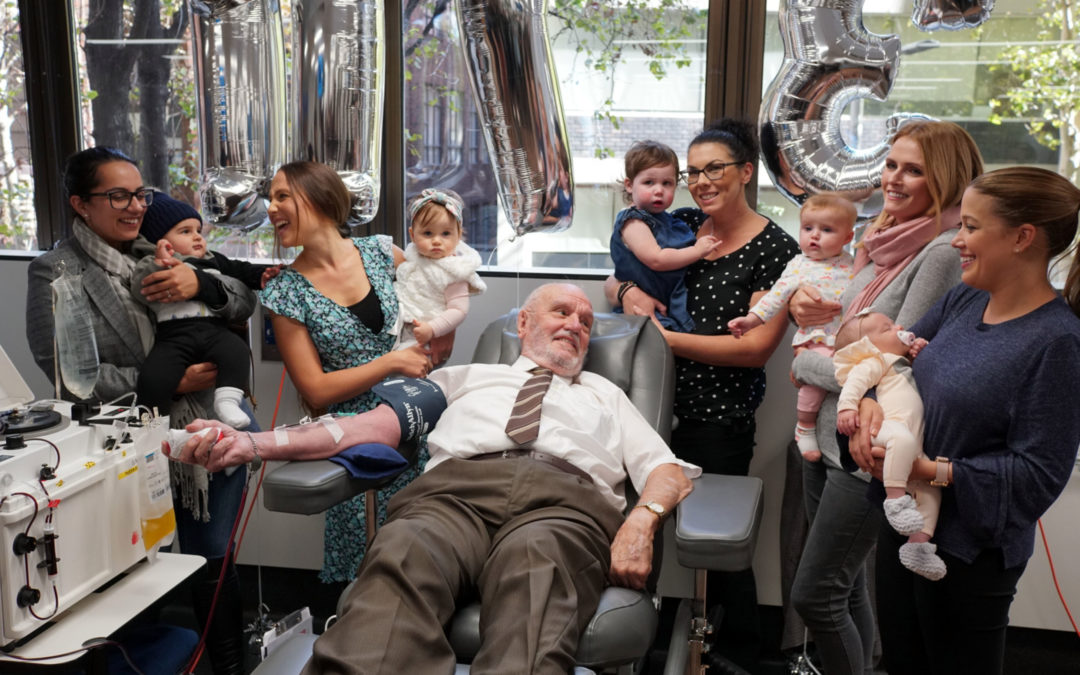1951 – A hospital in Sydney Australia: After four grueling hours, doctors successfully removed a diseased lung from 14-year-old James Harrison. The following three days were touch and go for James; he required 13 units of blood to stay alive. His first recollection following surgery was of his father, a Red Cross blood donor, telling him about the gift of life he had received. Thirteen strangers had given blood to save his life.
During his three-month hospital stay, James grew to hate needles and the sight of blood, particularly his own. Nevertheless, he vowed to his father that he would become a blood donor one day. As promised, James donated his first pint of blood one week after his 18th birthday, the minimum requirement age for donating blood in Australia. During the next decade, he consistently gave blood as often as the Red Cross would let him give – every three weeks.
Meanwhile, in the 1960’s, pregnant mothers in Australia were losing babies at an alarming rate. Miscarriages were occurring in more than 15 percent of pregnancies and many babies were stillborn or born with brain damage. Doctors eventually discovered the cause was due to a condition known as Rhesus D Hemolytic Disease, or HDN, a blood incompatibility between the mother and her baby. If a mother had Rh-negative blood but her baby had Rh-positive blood received from the father, the mother’s red blood cells would attack the fetus.
Researchers thought it might be possible to treat the condition by injecting mothers with blood plasma containing a rare antibody. They searched blood bank donor lists looking for the rare antibody and only found 50 possible donors in the entire country, including 29-year-old James Harrison from New South Wales. James readily volunteered for the experiment. Given the risks, the research program insured his life for one million dollars. Should something unfortunate happen to James during the trial, his wife would be compensated.
Scientists developed an injection with James’ plasma called Anti-D. In 1967, the first dose of Anti-D was given to a pregnant mother at Royal Prince Alfred Hospital. The serum was a success and James agreed to donate blood plasma regularly to the program.
May 2018 – Sydney, Australia: On Friday, May 11, 2018, James Harrison made his 1,173rd and final donation of blood. He was surrounded by ten mothers and babies successfully treated with Anti-D produced from his blood plasma. At age 81, he had reached the Australian Red Cross mandatory retirement age for blood donors.
Physicians believe James’ rare blood type resulted from the blood transfusions he received as a child. The Red Cross estimates that his rare blood type saved the lives of 2.4 million babies, including his own grandson. Every dose of Anti-D serum ever developed in Australia has some of James’ plasma.
James’ 1,173 donations, a Guinness world record, are even more incredible based on how he feels about needles. “I never once looked at the needle,” James laments. “I concentrated on the ceiling. I can’t stand needles, the sight of blood, or pain. I’d like to keep going but the Red Cross told me I had to quit at 81.” Disappointed that he can no longer donate blood to the Red Cross, James hopes that one of the 50 people with the rare blood type will carry on in his stead.
“At the end of the day it is not about what you have or even what you have accomplished…it’s about who you lifted up. It is about what you have given back.” Denzel Washington

great story. Thanks